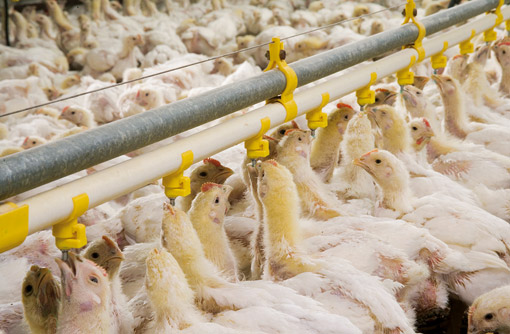Steps to beat infectious bronchitis in poultry

Infectious bronchitis threatens productivity across the layer, breeder and broiler sectors. In the first of a new three-part sponsored series, two leading experts in the field give an overview of the disease
Infectious bronchitis is a disease that remains a threat to UK poultry health. Over the past 10 years, how has it affected the industry?
TC: In the last 10 years the free-range sector has grown significantly, and the birds’ exposure to IB has also increased. Italian 02 has been and gone, Massachusetts-type and IB 491-type viruses are still around, and QX-like viruses have reached UK backyard, broiler and layer flocks.
Some new recombinant IB viruses have also been detected, but their significance has not been studied.
With no national database, it is difficult to assess the impact of disease and this is compounded by the fact that producers have adapted their vaccination strategies and introduced DO IB vaccination in many commercial layer and breeder flocks.
AB: The negative impact on performance has meant that, where a positive diagnosis of IB has been obtained, the already tight profit margins have been squeezed even more. In the commercial layer and broiler breeder sectors, this has resulted in lost revenue due to increased levels of reject eggs and the presentation of the so-called “false layer”.
The broiler sector is likely to have had the higher burden due to IB infections, with loss in daily weight gain and uniformity, but more importantly, a severe deterioration in shed litter conditions resulting in an increased incidence of pododermatitis and hock burn.
Looking at the disease on-farm, how would you typify the severity of an outbreak in broilers and layers?
TC: In broilers it is usually a co-infection with other viruses and bacteria, such as mycoplasma, which causes respiratory symptoms, airsacculitis and so on. Some IB viruses target the kidneys, damaging water metabolism of the birds resulting in mortalities and wet litter. This can lead to problems such as pododermatitis and enteric diseases.
Meet the experts
 Tibor Cserep qualified as a vet in Hungary before graduating in 1990 from The Royal Veterinary School, Edinburgh. He was company veterinarian for a major poultry breeding company in the UK prior to joining MSD Animal Health 1996. As technical manager for the poultry division, Mr Cserep works closely with UK vets and poultry producers and provides a link between pharmaceutical and practical management of bird health.
Tibor Cserep qualified as a vet in Hungary before graduating in 1990 from The Royal Veterinary School, Edinburgh. He was company veterinarian for a major poultry breeding company in the UK prior to joining MSD Animal Health 1996. As technical manager for the poultry division, Mr Cserep works closely with UK vets and poultry producers and provides a link between pharmaceutical and practical management of bird health.
 Allan Ball obtained a degree in veterinary science from the University of Pretoria in 2003. Having worked as a company vet and regional lab manager for Rainbow Farms in South Africa, he moved to Cobb Europe in April 2007. As a quality assurance manager and company veterinarian, he serviced internal breeding flock health status, and offered veterinary advice to external customers. In 2008, Mr Ball moved to Slatehall Veterinary Practice as an associate veterinarian, with main areas of interest being broilers and broiler breeders. He is a company director.
Allan Ball obtained a degree in veterinary science from the University of Pretoria in 2003. Having worked as a company vet and regional lab manager for Rainbow Farms in South Africa, he moved to Cobb Europe in April 2007. As a quality assurance manager and company veterinarian, he serviced internal breeding flock health status, and offered veterinary advice to external customers. In 2008, Mr Ball moved to Slatehall Veterinary Practice as an associate veterinarian, with main areas of interest being broilers and broiler breeders. He is a company director.
IB in layers is associated with egg shell defects and egg drops. These symptoms are not specific to IB, which is why many other diseases can be misdiagnosed as IB. On the other hand, IB often joins forces with other viruses and bacteria, causing longer lasting and more severe disease.
When IB damages the oviduct of very young chicks they do not die, but may become “blind layers” by the time they reach sexual maturity.
AB: The severity of an outbreak of IB on a farm depends on two main issues: the level of challenge and the level of protection that the bird exhibits at the time of challenge.
Broiler flocks can present with varying clinical signs, ranging from a mild snick to severe respiratory signs, mild to severe wet litter due to kidney damage, and poor and/or uneven daily and terminal growth rates.
Laying flocks may typically present with a moderate production drop, possibly followed by an increase in egg rejection rates, for example white, weak shelled, waist-lined eggs. Due to live priming and inactivated IB vaccines being administered to layers, respiratory signs are unlikely to be the presenting clinical signs.
What practical steps can producers take to prevent an outbreak?
TC: Producers should minimise the carry-over of IB from other farms, and from shed to shed within their own farms, by implementing stringent biosecurity measures.
They should also reduce the carry-over of IB and other pathogens from crop to crop on the same farm, by allocating enough downtime and implementing a thorough hygiene programme.
Based on discussions with their vets, they should use the correct vaccine at the correct time and administer it properly. MSD can offer help in vaccination audits and training.
Ammonia can severely damage the protective mucus membrane of the trachea. When this happens, pathogens such as IB can gain easy access to the respiratory system and cause disease. Removing ammonia by adequate ventilation can mitigate this damaging effect and the concentration of pathogens in the air.
AB: On top of these measures, surveillance is also crucial. The producer should be aware of what level of IB challenge is in the region by openly communicating available information with neighbouring producers, as well as obtaining advice from their veterinarian.
Other surveillance may include terminal serology IB testing from the broiler flocks, or paired serum samples with a three-week testing interval in broiler breeder and layer flocks.
Due to the nature of cross reactions between variants in different vaccines, serology testing may not be conclusive. It is therefore important to “trend” flocks, to review changes in titre groups rather than interpret absolute titre levels.
Serology testing should be done in conjunction with Polymerase Chain Reaction (PCR) testing to confirm the presence or absence of a variant strain. The choice on vaccination will depend on the perceived level of IB challenge, and also by taking into account the results from the surveillance testing which has been completed. There are many live priming and inactivated vaccines available.
What are the priorities for an optimal vaccination strategy?
TC: You need to know your “enemies” and prioritise them. Work with your vets to find out what pathogens are present in your farm and area, and develop a health plan that includes a vaccination programme focused on prioritised “enemies”. Find out what application technique is best for delivering the vaccines in your programme. Ask for help if you need it for vaccine administration. Monitor vaccination by serology and other methods.
AB: The surveillance testing that has been completed should give the poultry producer an idea of the level of challenge in the region, and hence make the decision of vaccination that much easier. Day-old IB vaccination is always applied as a coarse spray. The on-farm vaccination may be applied as a spray, or through the drinking water system. It would be recommended that, where there is a high challenge, the IB vaccine be applied as a spray to ensure direct contact with the birds’ respiratory tracts, in most cases the entry portal for IB infections.
Where more than one IB variant is confirmed, can individual vaccines or combinations provide effective cross-protection?
TC: In most cases we face a “multifactorial challenge” on farms. There are very few flocks nowadays that are vaccinated only with one type of IB vaccine. The majority of them are vaccinated with both Massachusetts and a variant-type vaccine, utilising the “protectotype” concept. Some vaccines can provide cross protection against other types of IB viruses and combining these in a programme can induce a very good level of cross protection against a broad range of IB viruses.
AB: Trials suggest that the highest level of immunity is obtained by ensuring the bird is exposed to as many IB variants as possible. This may come with its limitations as frequent vaccination on farms would, in all likelihood, fall outside the licensed uses of the products available.
Certain vaccine combinations have shown to provide greater levels of cross-protection when more than one variant strain has been identified on farm. The two most recognised IB vaccination programmes for a high-risk broiler farm are a combination vaccine of Massachusetts and D274 strains at day-old, followed by a combination vaccine of Massachusetts and Arkansas strains on farm; or Massachusetts strain at day-old, followed by 4/91 strain on farm.
Once a successful vaccination strategy has been implemented, how can producers best protect against new variant challenges?
TC: Again, they should revert to the biosecurity, hygeine, vaccination, ventilation strategy outlined above.
AB: There is continuous work being completed by pharmaceutical companies to ascertain the levels of cross-protection offered between different IB vaccination programmes. Firstly, one needs to establish if a new variant is present on the farm before jumping to any decisions about bolstering an already successful vaccination programme. If a new variant is identified by means of PCR testing or virus isolation, the vaccination programme may be altered to include this variant strain, or change to a combination vaccine which may offer a higher level of cross protection.
Working to promote healthy production
The MSD Animal Health Poultry team works with UK vets and their clients to develop programmes and strategies to promote healthy production using the company’s vaccines and poultry health products.
The following MSD IB vaccines are provided under veterinary direction:
- Nobilis IB 4-91: live variant IB strain vaccine for in water or spray vaccination.
- Nobilis Ma5: Massachusetts (classical) IB strain vaccine for in water or spray vaccination.
- Nobilis Ma5+clone 30: live Massachusetts (classical) IB strain combined with Newcastle Disease virus for in water or spray vaccination.
- A range of inactivated Noblis vaccines containing IB strains are also available.
 To assist producers and their vets, MSD Animal Health works in collaboration with X-OvO Diagnostic Solutions to provide IB strain identification and interpretation.
To assist producers and their vets, MSD Animal Health works in collaboration with X-OvO Diagnostic Solutions to provide IB strain identification and interpretation.
